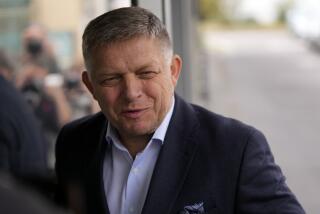Afghanistan Fault Lines Are Showing
- Share via
KABUL, Afghanistan — The attempted assassination of President Hamid Karzai in Kandahar and a devastating car bombing in Kabul on Thursday constitute the clearest threat yet to Karzai’s transitional government, which took office in June with strong U.S. backing.
Although no evidence was immediately released tying the events together, the attacks appeared to be coordinated and they were seen here as a declaration by remnants of Al Qaeda and the Taliban that Afghanistan’s slow progress would not continue without a fight.
Even though U.S. forces are providing security for Karzai, and killed his assailant, perhaps the most enduring result of the attacks Thursday will be to raise the question of whether the international community in general, and the U.S. specifically, is doing enough to ensure the success of Karzai’s government. The role of U.S. troops, who may have saved the life of a key politician working to build a unified and moderate Afghanistan, underscores how difficult it will be for the United States to withdraw any time soon.
In addition to snuffing out lives and damaging property, the attacks will also hurt Afghanistan’s effort to attract much-needed foreign investment. Government officials have said recently that companies seemed to be sitting on their hands, waiting until after Sept. 11 to make any business deals.
The Afghan government said it had been bracing for some kind of assault in connection with the first anniversary of the Sept. 11 attacks on the United States and the Sept. 9 assassination of anti-Taliban warrior Ahmed Shah Masoud. But Thursday’s twin attacks still shocked people, mainly because things had been going relatively smoothly.
In the nine months since the Taliban regime was routed from its last bastion in the southern city of Kandahar, a complex effort by the United States, its allies and the new Afghan government seemed to be bringing stability to the country.
For the first time since a Communist coup in the mid-1970s, a government has been selected by all the communities of Afghanistan in a broadly democratic forum.
There have been some attacks on U.S. forces in eastern Afghanistan, where the hunt for remnants of the Al Qaeda terrorist network continues near the Pakistani border, and there have been occasional, mostly harmless explosions in the capital. But overall, the country had settled into a period of calm.
Instead of gunfire and explosions, the typical sound of a day in Afghanistan had become the bustle of people going to jobs, the grinding gears of old jalopies bringing home refugees from Pakistan and Iran, and the sounds of construction as humanitarian workers and the United Nations repaired schools, electrical systems and other important services.
Afghanistan had faded somewhat on the international radar screen, replaced by the debate about whether the United States should move against Iraq. But the attacks Thursday stand as a reminder that the work of rebuilding Afghanistan and making it safe from the threat of terrorism is far from over.
One obvious question in recent weeks was whether the nearly 5,000-member international security force in Kabul should be expanded to cover other parts of the country, where central authority still is weak and warlords and criminals make life difficult for ordinary people.
The Bush administration has been lukewarm about expanding the peacekeepers’ role. Washington has said that it would not provide U.S. troops for an expanded force and that a better approach would be to train a new, non-factional Afghan army to provide security throughout the country.
But U.N. officials have warned that creation of a national army is taking too long and that continued lawlessness in some provinces is discouraging ordinary Afghans from backing their new government.
There have been indications lately that the U.S. was softening its opposition to expanding the area where the International Security Assistance Force operates, but no firm decisions have been made.
Another question has been how quickly the United States and other big donors in Europe and Japan will deliver on pledges of $1.8 billion in aid for this year to get Afghanistan back on its feet. Only about $800 million has so far been received, and Karzai’s government has been warning that it will lose the trust of its people unless they see some big government projects that provide jobs, such as the rebuilding of major national highways.
Karzai travels to New York next week for the U.N. General Assembly meeting, Sept. 11 ceremonies at the former site of the World Trade Center and a meeting with President Bush. He is likely to press Bush to agree to expand the international force and speed up aid deliveries.
Although the car bombing in Kabul exacted an awful toll, the attack on Karzai was arguably more disturbing for U.S. policy. It is hard to imagine how the new government could recover from an assassination of Karzai, a man who carries the world’s hopes for a reborn Afghanistan. There is no political figure who approaches Karzai in the ability to unify the country and its various ethnic groups under a banner of moderation and inclusion.
The attack Thursday was Karzai’s second brush with death since he took up the fight to oust the Taliban from his homeland. He almost died during a battle near Kandahar last December when a U.S. airstrike was called in too close to his position. The bombing took place on the same day that Karzai was first nominated to lead what was then the country’s interim administration.
U.S. forces assumed responsibility for Karzai’s personal security shortly after the assassination of Vice President Haji Abdul Qadir in July. That now seems to have been a prescient decision, one that might have saved the Afghan president’s life.
There is one other bright spot for U.S. interests in Afghanistan after Thursday’s attacks: the genuine disgust expressed by ordinary Afghans over the car bombing and their frank appreciation of international support.
Mohammed Reza, a 33-year-old government employee who witnessed the carnage, said, “Protecting Afghanistan is 50% the job of our forces and 50% the job of the Americans. Their presence here is valuable and worthy for us. If there was no need, why else would they be here?”
More to Read
Sign up for Essential California
The most important California stories and recommendations in your inbox every morning.
You may occasionally receive promotional content from the Los Angeles Times.










